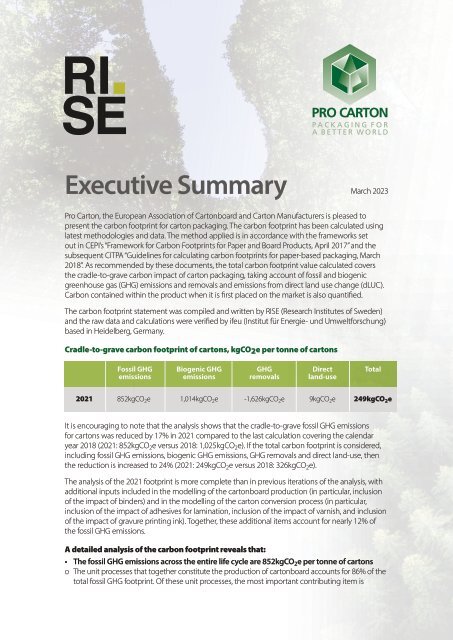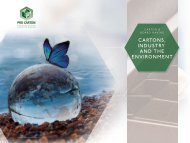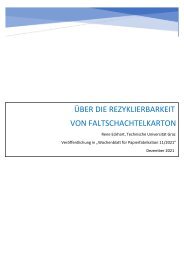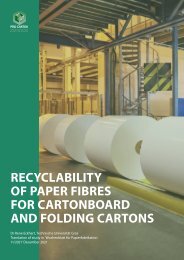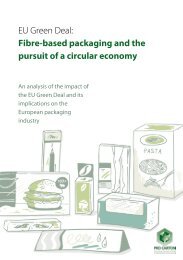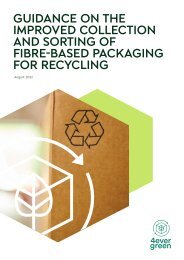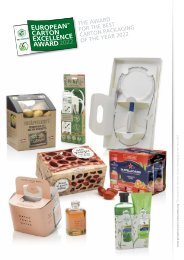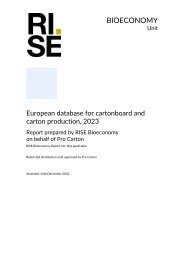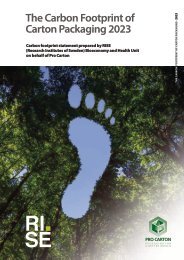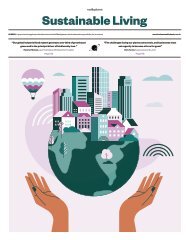2023 Carton Carbon Footprint Study – Executive Summary
- No tags were found...
You also want an ePaper? Increase the reach of your titles
YUMPU automatically turns print PDFs into web optimized ePapers that Google loves.
RI<br />
SE<br />
<strong>Executive</strong> <strong>Summary</strong><br />
March <strong>2023</strong><br />
Pro <strong>Carton</strong>, the European Association of <strong>Carton</strong>board and <strong>Carton</strong> Manufacturers is pleased to<br />
present the carbon footprint for carton packaging. The carbon footprint has been calculated using<br />
latest methodologies and data. The method applied is in accordance with the frameworks set<br />
out in CEPI’s “Framework for <strong>Carbon</strong> <strong>Footprint</strong>s for Paper and Board Products, April 2017” and the<br />
subsequent CITPA “Guidelines for calculating carbon footprints for paper-based packaging, March<br />
2018”. As recommended by these documents, the total carbon footprint value calculated covers<br />
the cradle-to-grave carbon impact of carton packaging, taking account of fossil and biogenic<br />
greenhouse gas (GHG) emissions and removals and emissions from direct land use change (dLUC).<br />
<strong>Carbon</strong> contained within the product when it is first placed on the market is also quantified.<br />
The carbon footprint statement was compiled and written by RISE (Research Institutes of Sweden)<br />
and the raw data and calculations were verified by ifeu (Institut für Energie- und Umweltforschung)<br />
based in Heidelberg, Germany.<br />
Cradle-to-grave carbon footprint of cartons, kgCO2e per tonne of cartons<br />
Fossil GHG<br />
emissions<br />
Biogenic GHG<br />
emissions<br />
GHG<br />
removals<br />
Direct<br />
land-use<br />
Total<br />
2021<br />
852kgCO 2 e 1,014kgCO 2 e -1,626kgCO 2 e 9kgCO 2 e 249kgCO 2 e<br />
It is encouraging to note that the analysis shows that the cradle-to-grave fossil GHG emissions<br />
for cartons was reduced by 17% in 2021 compared to the last calculation covering the calendar<br />
year 2018 (2021: 852kgCO 2 e versus 2018: 1,025kgCO 2 e). If the total carbon footprint is considered,<br />
including fossil GHG emissions, biogenic GHG emissions, GHG removals and direct land-use, then<br />
the reduction is increased to 24% (2021: 249kgCO 2 e versus 2018: 326kgCO 2 e).<br />
The analysis of the 2021 footprint is more complete than in previous iterations of the analysis, with<br />
additional inputs included in the modelling of the cartonboard production (in particular, inclusion<br />
of the impact of binders) and in the modelling of the carton conversion process (in particular,<br />
inclusion of the impact of adhesives for lamination, inclusion of the impact of varnish, and inclusion<br />
of the impact of gravure printing ink). Together, these additional items account for nearly 12% of<br />
the fossil GHG emissions.<br />
A detailed analysis of the carbon footprint reveals that:<br />
• The fossil GHG emissions across the entire life cycle are 852kgCO 2 e per tonne of cartons<br />
o The unit processes that together constitute the production of cartonboard accounts for 86% of the<br />
total fossil GHG footprint. Of these unit processes, the most important contributing item is
emissions arising from the combustion of fossil fuels at the pulp and paper mills. Also important<br />
are emissions arising from purchased grid electricity at the mills, emissions arising from the<br />
production of non-fibre inputs at the mills (process chemicals and functional additives), emissions<br />
associated with the production of purchased fuels and emissions associated with production of<br />
purchased pulp. Emissions associated with the transport of raw materials (wood, paper for recycling,<br />
and non-fibre inputs) to the mill also contribute.<br />
o The unit process which together constitute the converting of cartonboard into cartons account for<br />
18% of the total fossil GHG footprint. Of these unit processes, the most important contributing item<br />
is the emissions associated with the production of purchased electricity consumed at the<br />
converting process. Emissions associated with the production of other constituents of the cartons<br />
(inks, varnish, glues, etc) are also important, along with emissions arising from fuels consumed<br />
onsite for the print drying process and for space heating.<br />
o Emissions associated with the delivery of cartonboard from the mill to the converter account for 5%<br />
of the total fossil GHG footprint.<br />
o Due to the credit received for avoided emissions arising from the energy recovery process, there is a<br />
net credit for the end-of-life processes (accounting for -9% of the total fossil GHG footprint).<br />
• The biogenic emissions across the life cycle are 1,014kgCO 2 e per tonne of cartons<br />
o Biogenic emissions arising from the combustion of biofuels at the pulp and paper mills account for<br />
the majority of the biogenic emissions (79%). This is predominantly from the combustion of internally<br />
generated biofuels such as black liquor, plus some small emissions from purchased biofuels.<br />
o Emissions from end-of-life processes account for just 18% of the Biogenic emissions. However, it<br />
should be remembered that carton packaging achieves a high recycling rate. No end-of life<br />
emissions occur within the boundaries of the analysis for the proportion of cartons that<br />
are recycled (although emissions will occur in the life cycles of subsequent products that are<br />
manufactured from the recovered fibres <strong>–</strong> the implications of this are investigated in the<br />
uncertainty analysis).<br />
• The emissions due to land-use (dLUC) are just 9kgCO 2 e per tonne of cartons<br />
o The dLUC emissions mostly arise from the production of non-fibre inputs rather than inputs of<br />
fibres from the forest, reflecting the fact that the fibres used in cartonboard production are sourced<br />
from sustainably managed forests. Forests in Europe are growing, deforestation (and emissions of<br />
greenhouse gases associated with deforestation) is not an issue that is relevant to the carton supply<br />
chain in Europe, as more trees are planted than harvested through sustainable forest management.<br />
o The dLUC emissions in the life cycle for cartons are primarily associated with the production of inks<br />
used in the converting process, as the extraction of specific minerals required for e.g. ink formulations<br />
may lead to localised land-use changes that result in a net release of emissions to the environment.<br />
• The GHG removals across the life cycle are -1,626kgCO 2 e per tonne of cartons<br />
o 96% of these removals relate to the CO 2 flows from the atmosphere into the forests during the<br />
growth phase of the wood that provides fibres and internal bioenergy at the pulp and paper mills.<br />
o The remaining removals relate to CO 2 flows from the atmosphere into biomass used for purchased<br />
biofuels and/or non-fibre natural and renewable raw materials (e.g. starches).<br />
• These emissions and removals can be summed to give us a total GHG footprint across the<br />
entire life cycle of 249kgCO 2 e per tonne of cartons.<br />
• In addition, the carbon content of the product when first placed on the market is 1,609kgCO 2 e per<br />
tonne of cartons. In line with the CITPA methodology, this value is provided as additional<br />
information only, and should not be subtracted from the total carbon footprint.<br />
The improvements in fossil GHG emissions of 17% compared to the 2018 figures are<br />
significant. The main drivers for these reductions have been improved resource efficiency during<br />
the converting process and investments in energy efficiency and renewable energy sources at<br />
the cartonboard mills and converting operations. Further investments in resource and energy<br />
efficiency and renewable energy sources should see continued reductions in the coming years.<br />
Horst Bittermann<br />
Director General<br />
Winfried Muehling<br />
Director Marketing & Communications


